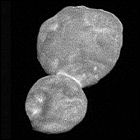 NASA’s New Horizons space probe, operated by Johns Hopkins University’s Applied Physics Lab, passes within 2,200 miles of the mysterious Kuiper Belt object 2014 MU69, a tiny fragment of leftover material from the birth of the solar system. Previously seen only as a tiny pixel even by the powerful lens of the Hubble Space Telescope, nothing was known of 2014 MU69 prior to the flyby, which revealed it as a contact binary: two bodies which had become gravitationally fused together. As 2014 MU69 (informally nicknamed Ultima Thule in a public poll conducted by the New Horizons public outreach team) is a billion miles further away than Pluto, and with New Horizons continuing outward at 30,000 miles per hour, signals between Earth and New Horizons take at least six hours to reach their destination, so the downlink of data from the flyby would take until 2020 to complete.
NASA’s New Horizons space probe, operated by Johns Hopkins University’s Applied Physics Lab, passes within 2,200 miles of the mysterious Kuiper Belt object 2014 MU69, a tiny fragment of leftover material from the birth of the solar system. Previously seen only as a tiny pixel even by the powerful lens of the Hubble Space Telescope, nothing was known of 2014 MU69 prior to the flyby, which revealed it as a contact binary: two bodies which had become gravitationally fused together. As 2014 MU69 (informally nicknamed Ultima Thule in a public poll conducted by the New Horizons public outreach team) is a billion miles further away than Pluto, and with New Horizons continuing outward at 30,000 miles per hour, signals between Earth and New Horizons take at least six hours to reach their destination, so the downlink of data from the flyby would take until 2020 to complete.
Tags:
Categories
Comments are closed